
Navigating the Latest CAR Regulations: A Comprehensive Guide for Dealerships
April 22, 2024
Jump to Section:
Introduction
The Federal Trade Commission's (FTC) Used Car Rule mandates compliance for most car dealerships that sell used vehicles. Specifically, dealerships that sell or offer for sale more than five used vehicles within 12 months are required to adhere to this Rule. Nevertheless, there are instances where certain entities are not required to adhere to these regulations, including banks, financial institutions, companies that provide vehicles to their staff, and lessors who sell a leased vehicle to the lessee, an employee of the lessee, or a buyer recommended by the lessee. Geographically, the Used Car Rule is enforced in all U.S. states, with the exceptions of Maine and Wisconsin—states with similar regulations requiring dealers to disclose information on used vehicles. Furthermore, the Rule extends to all use territories, including the District of Columbia, Puerto Rico, American Samoa, the U.S. Virgin Islands, and Guam. This guide outlines the specifics of the Rule, details how to properly prepare and display the Buyers' Guide, and provides a compliance checklist to ensure dealers meet all regulatory obligations. Dealers must prominently display the Buyers Guide before showing a vehicle or allowing a customer to inspect it for purchase—even if the car is not fully prepared for delivery. This rule pertains to pre-owned cars sold under consignment, power of attorney, or similar arrangements. At public auctions, dealers and auction companies are obliged to follow the Rule, though it does not apply to auctions closed to the general public. This Rule applies to vehicles used for purposes other than just transportation or testing, including light vans, trucks, demonstrators, and program cars meeting specific criteria: a GVWR of under 8,500 pounds, a curb weight under 6,000 pounds, and a frontal area less than 46 square feet. These types of vehicles are subject to the regulations outlined in this Rule. Several exceptions exist to this rule. Motorcycles, vehicles sold for scrap or parts — contingent on the dealer submitting title documents to the relevant state authority and obtaining a salvage certification — and agricultural equipment are exempt from these regulations. This introduction provides a foundational understanding of the FTC's Used Car Rule, ensuring dealers are well-informed of their responsibilities and the vehicles under this regulation.
1. Buyers' Guide
This section elaborates on the Buyers' Guide, underscoring its critical role in promoting transparency and protecting consumer rights in used car transactions.
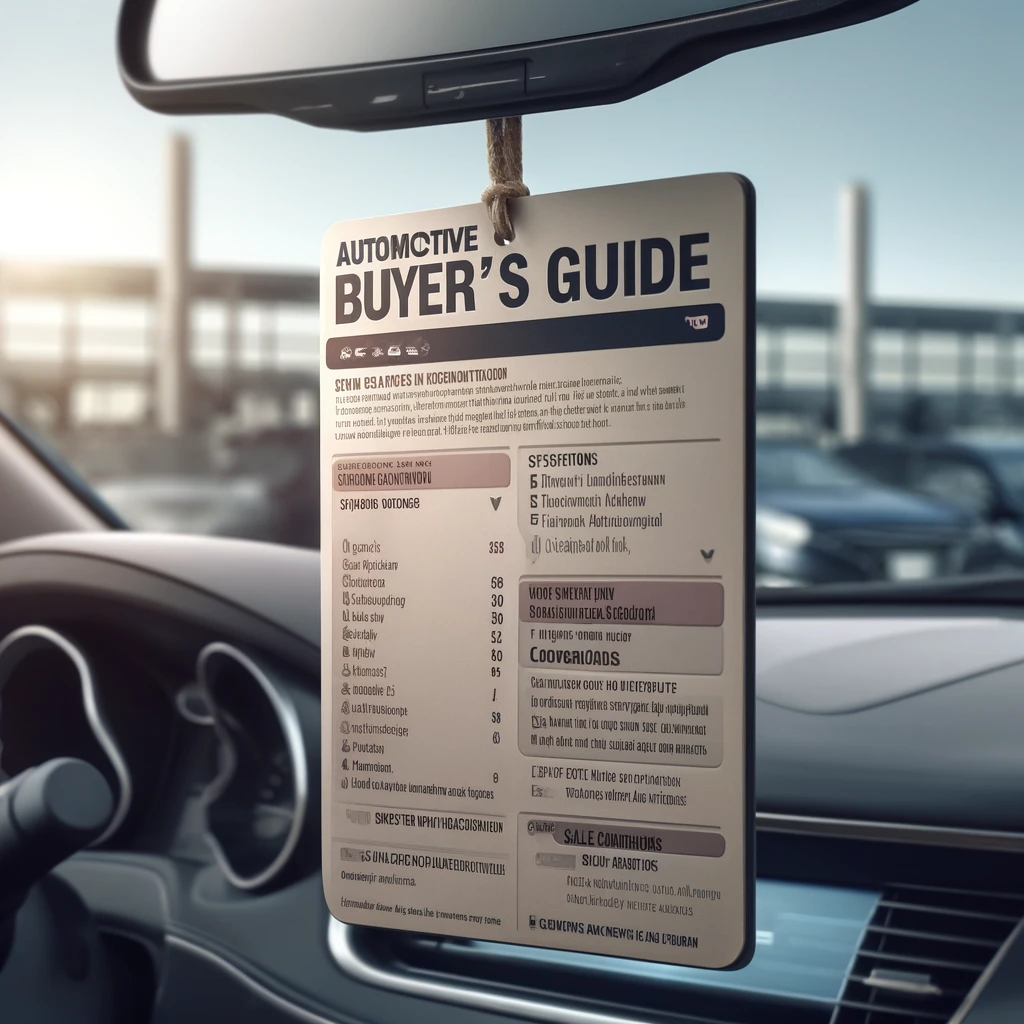
Purpose and Importance
The Buyers' Guide is a fundamental disclosure tool that informs consumers about the condition and warranty terms of the used vehicle they are considering. It is designed to prevent misunderstandings and enhance consumer confidence by providing essential purchasing information.
Contents of the Guide
- System Information: This section details the car's major mechanical and electrical systems, including potential major issues to watch out for.
- Warranty Coverage: Indicates whether the vehicle is sold with a warranty and what percentage of repair costs the warranty covers.
- Sale Conditions: Specifies if the vehicle is being sold "as is" or under certain conditions that affect the buyer’s decision.
- Verification Suggestions: Advises buyers to secure all promises in writing, seek independent mechanic inspections, obtain vehicle history reports, and check for safety recalls.
- Language Options: This section informs about the availability of the Buyers' Guide in Spanish, particularly important if the transaction is conducted in Spanish.
Requirements for Display
The Buyers' Guide should be visible on or in the vehicle for sale. This visibility ensures that all potential buyers can easily access and review the guide before deciding. Acceptable display locations include:
- Hanging from the rear-view or side-view mirror.
- Placed under a windshield wiper or attached to a side window.
- It should not be hidden in areas like the glove compartment, trunk, or under the seat, as these are not considered conspicuous places.
Handling During Test Drives
The Buyers' Guide can be temporarily removed for test drives but must be replaced immediately afterward to ensure ongoing compliance and information availability.
Regulatory Compliance
Adherence to these guidelines is not just good practice—it's a legal requirement enforced by the Federal Trade Commission (FTC). Failure to comply can result in significant penalties, reinforcing the necessity of maintaining accurate and visible vehicle guides.
2. Vehicle Information
Learn about the specific criteria that classify a vehicle as 'used' and what information must be provided in the Buyers' Guide to ensure transparency and compliance.
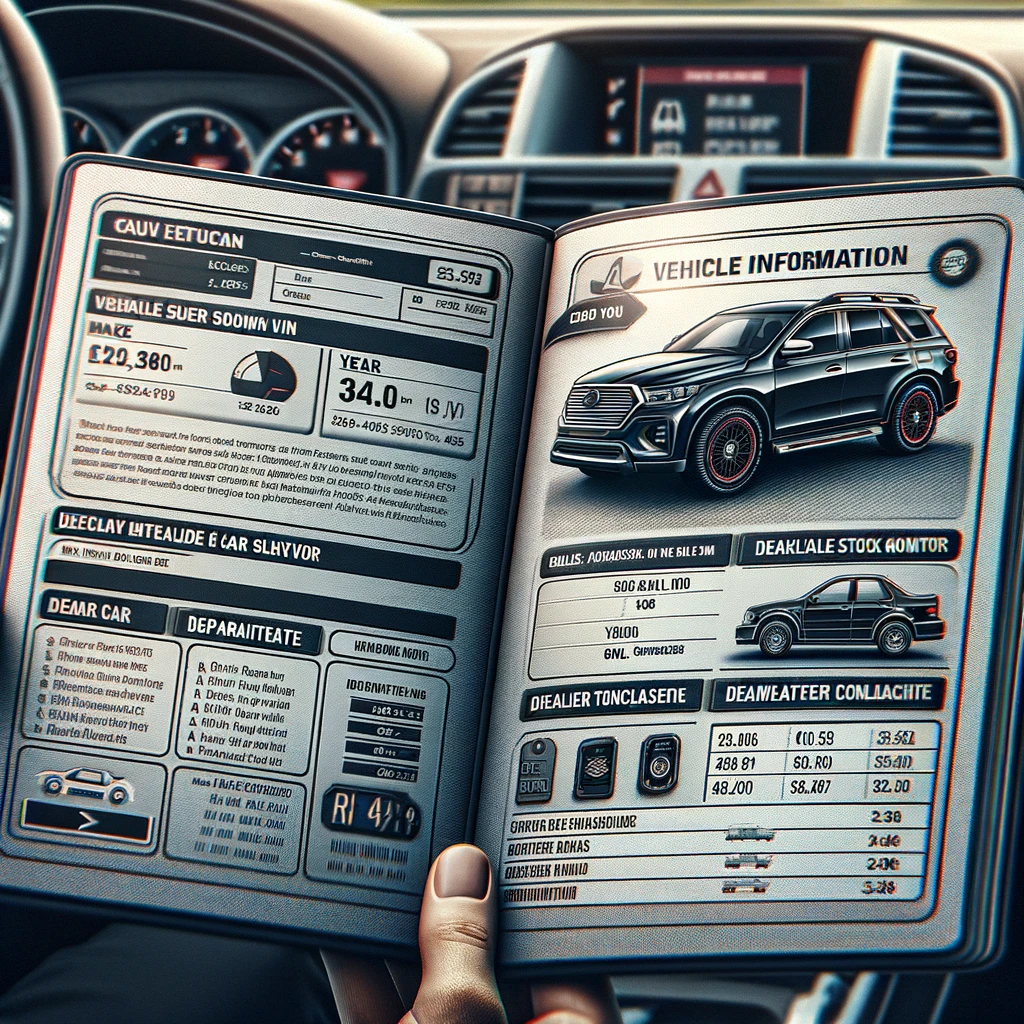
Vehicle Specifications
This section of the Buyers' Guide requires detailed information about the vehicle, which includes:
- Make and Model: The manufacturer and model of the vehicle.
- Model Year: The vehicle's production year.
- Vehicle Identification Number (VIN): A unique code used to identify the vehicle.
- Dealer Stock Number: Optionally, the inventory number assigned by the dealership.
These details help potential buyers verify the vehicle's identity and understand its background.
Dealer Obligations
Dealers must provide comprehensive and accurate information about the vehicle's condition and history on the back of the Buyers' Guide. This includes:
- Dealership Name and Address: The official name and location of the dealership.
- Contact Information: The name or position, along with the telephone number of the person to contact for any complaints. This information can be preprinted or stamped onto the Guide.
Optional Signature Line
Incorporating a signature line on the Buyers' Guide is optional but recommended to confirm receipt:
- Acknowledgment of Receipt: A line where the buyer signs to acknowledge that they have received the Guide, enhancing the formality and validity of the information provided.
- Required Disclosure: Adjacent to the signature line, include: "I hereby acknowledge receipt of the Buyers' Guide at the closing of this sale." This disclosure ensures both parties know the information and agreements made during the sale.
These details must be presented clearly to support buyer awareness and legal compliance. This section informs the buyer and protects the dealer by making all disclosures transparent.
3. Dealer Information
This section provides detailed guidance on what dealers must include about themselves in the Buyer's Guide to ensure compliance and facilitate consumer relations.
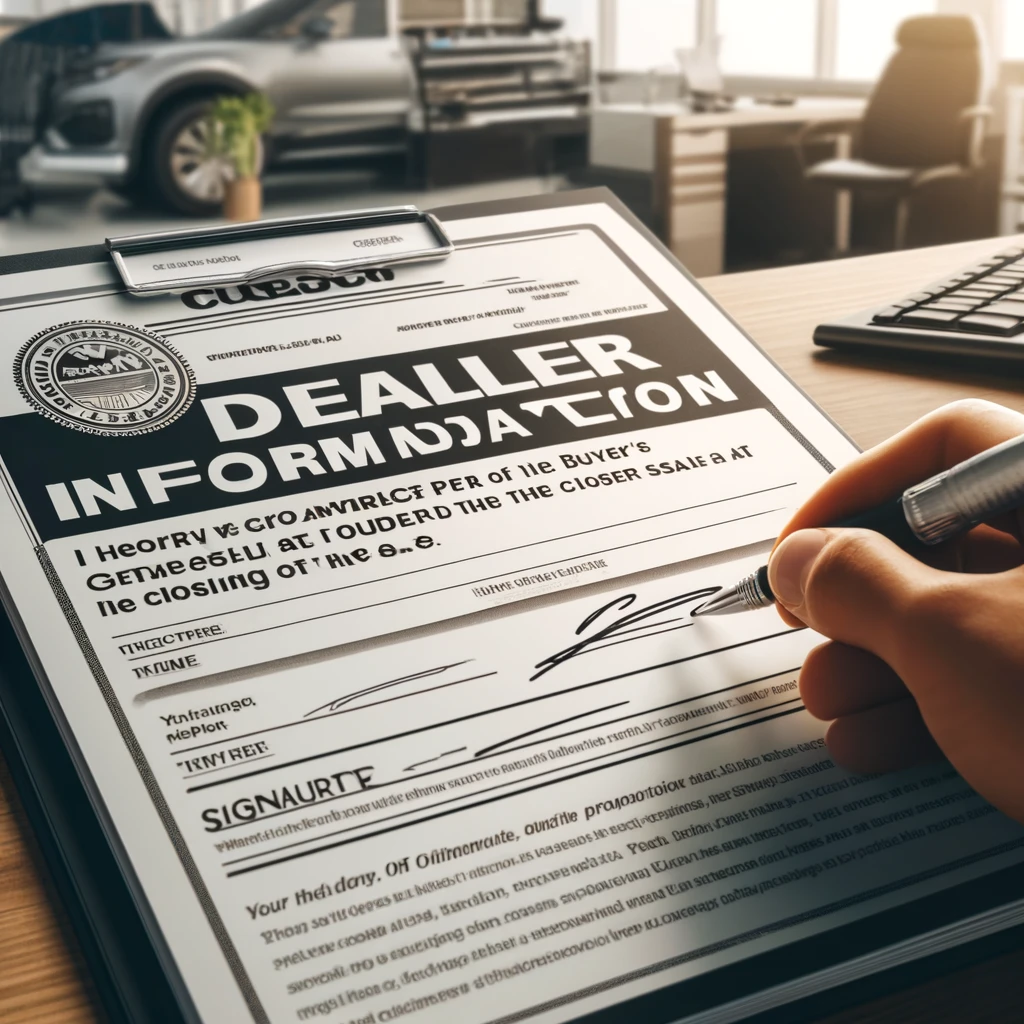
Essential Dealer Details
The Buyers' Guide must contain specific information about the dealership to ensure transparency and provide clear contact points for consumer inquiries and complaints:
- Dealership Name and Address: Clearly state the full legal name and physical address of the dealership. This information is crucial for any formal communication or if a customer needs to visit.
- Contact Information: Provide the name (or job title) and the direct telephone number of the individual responsible for handling customer complaints. This role is typically held by a customer service manager or a similar position within the dealership.
Optional Signature Line
Including a signature line on the Buyers' Guide can enhance the formality of the transaction and affirm the dealer's commitment to transparency:
- Acknowledgment of Receipt: Encourage the buyer to sign the Guide to acknowledge that they have received and reviewed all the disclosed information. This action helps prevent disputes related to disclosure.
- Required Disclosure Near Signature Line: Adjacent to the signature line, include the statement: "I hereby acknowledge receipt of the Buyers' Guide at the closing of this sale." This ensures that the buyer is fully aware of the documented terms and conditions associated with the sale.
- Placement: Ensure that the signature line and the accompanying disclosure are prominently placed on the Guide, typically at the bottom or on the back, where they can be easily noticed and read.
This structured approach aligns with regulatory requirements and builds a foundation of trust between the dealership and the buyer, reinforcing the dealer's commitment to transparency and consumer rights.
4. F&I Products
Exploring the financial and insurance products dealers offer, focusing on warranty and service contract details that impact the cost and terms of vehicle purchases.
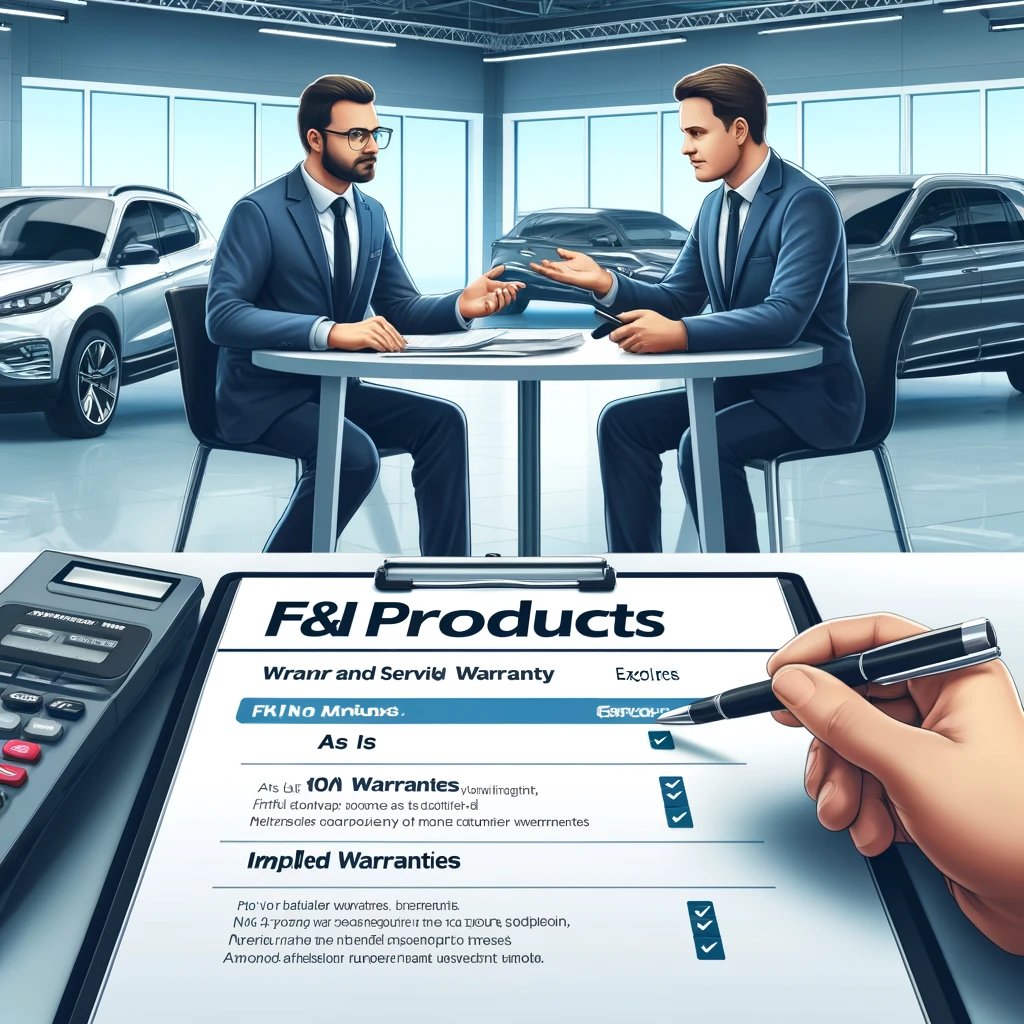
Overview of F&I Products
Finance and Insurance (F&I) products play a crucial role in the car-buying process, providing buyers with essential financial and insurance options. This section details the types of warranties and service contracts available, which help manage both expected and unforeseen vehicle expenses.
Types of Warranties
Warranties are critical in providing buyers with confidence and security in their vehicle purchase:
- As Is-No Dealer Warranty: This option is available if state law permits, indicating no warranty is offered. The Buyers' Guide will mark this status, absolving the dealer of certain after-sale obligations.
- Implied Warranties Only: Some states restrict the sale of vehicles "as is." In such cases, dealers must indicate that only implied warranties apply, ensuring basic legal protection for the buyer.
- Express Warranties: When dealers offer an explicit warranty, details must be clearly outlined in the Buyers' Guide, including the extent of coverage and the specific components covered under the warranty.
Understanding Warranty Specifications
- Coverage Details: Buyers' should be informed of what percentage of repair costs the warranty covers and whether there are any deductibles (e.g., "$50 deductible per repair visit").
- System Coverage and Duration: The guide must list which vehicle systems are covered and for how long, avoiding vague terms to ensure clarity.
- Full vs. Limited Warranties: Full warranties cover the complete cost of repairs and provide replacements or refunds if the vehicle cannot be fixed after a reasonable amount of attempts. Limited warranties have restrictions.
Service Contracts
- Scope of Service Contracts: Often similar to extended warranties, service contracts provide repair services under specific terms. They must be differentiated from warranties and disclosed adequately if regulated as insurance in your state.
- Regulatory Compliance: It’s essential to verify whether service contracts are considered insurance products in your state, affecting how they should be offered and marketed.
Negotiating Warranty Terms
Negotiated changes to the warranty must be clearly documented on the Buyers' Guide to reflect any special agreements made at the point of sale, such as increasing the coverage percentage from 50% to 100%.
Consumer Benefits and Considerations
- Security and Peace of Mind: Warranties and service contracts can significantly mitigate the financial risk associated with costly repairs.
- Cost-Effectiveness: While these products can add to the initial cost of purchasing a vehicle, they may save money in the long term by covering expensive repairs.
5. Sale/Post-Sale
Here are the guidelines and requirements for dealers during and after the sale of a vehicle, focusing on essential documents and warranty services.

At the Time of Sale
When finalizing a vehicle sale, dealers must adhere to specific requirements to ensure transparency and compliance:
- Buyers' Guide Delivery: At the point of sale, provide the buyer with the original or a copy of the vehicle's Buyers' Guide. This guide must reflect all final changes, including any negotiated warranty terms.
- Signature Requirement: If the Buyers' Guide includes a signature line, ensure the buyer signs it to acknowledge receipt of the guide and its terms.
- Compliance with Federal Laws: Adhere to the Magnuson-Moss Warranty Act and the FTC's Warranty Disclosure Rule, which mandate clear disclosure of warranty coverage and consumer rights.
Post-Sale Obligations
Following the sale, dealers have ongoing responsibilities related to warranty services and disclosures:
- Warranty Services: Clearly explain the terms of any provided warranty, including what is covered and for how long. If the manufacturer’s warranty still applies, this must be disclosed clearly to the buyer.
- Split Cost Warranties: If offering warranties where costs are shared (e.g., 50/50 warranties), disclose the exact percentage of repair costs covered by the dealer and the buyer. Include specifics on how repair costs are calculated and when deductibles apply.
- Warranty Documentation: Ensure that all warranty terms are documented in a manner that complies with state laws and FTC guidelines. The Buyers' Guide cannot be a written warranty; separate documentation is necessary.
Availability of Warranty Information
- Pre-Sale Availability: The FTC's Rule on Pre-Sale Availability of Written Warranty Terms requires that written warranties be available near the vehicle or upon request before purchase.
- Access to Warranty Information: Buyers' should know where and how to access copies of the Buyers' Guide and warranty information. This may include downloading them from the FTC's Business Center or obtaining them directly from the dealership.
Additional Resources
Provide buyers with resources for understanding their rights under federal warranty laws, such as access to "A Businessperson's Guide to Federal Warranty Law" and other helpful materials.
6. Legal Compliance
This section provides a comprehensive overview of the legal responsibilities and consequences of non-compliance with the FTC's Used Car Rule, including how to access further information.
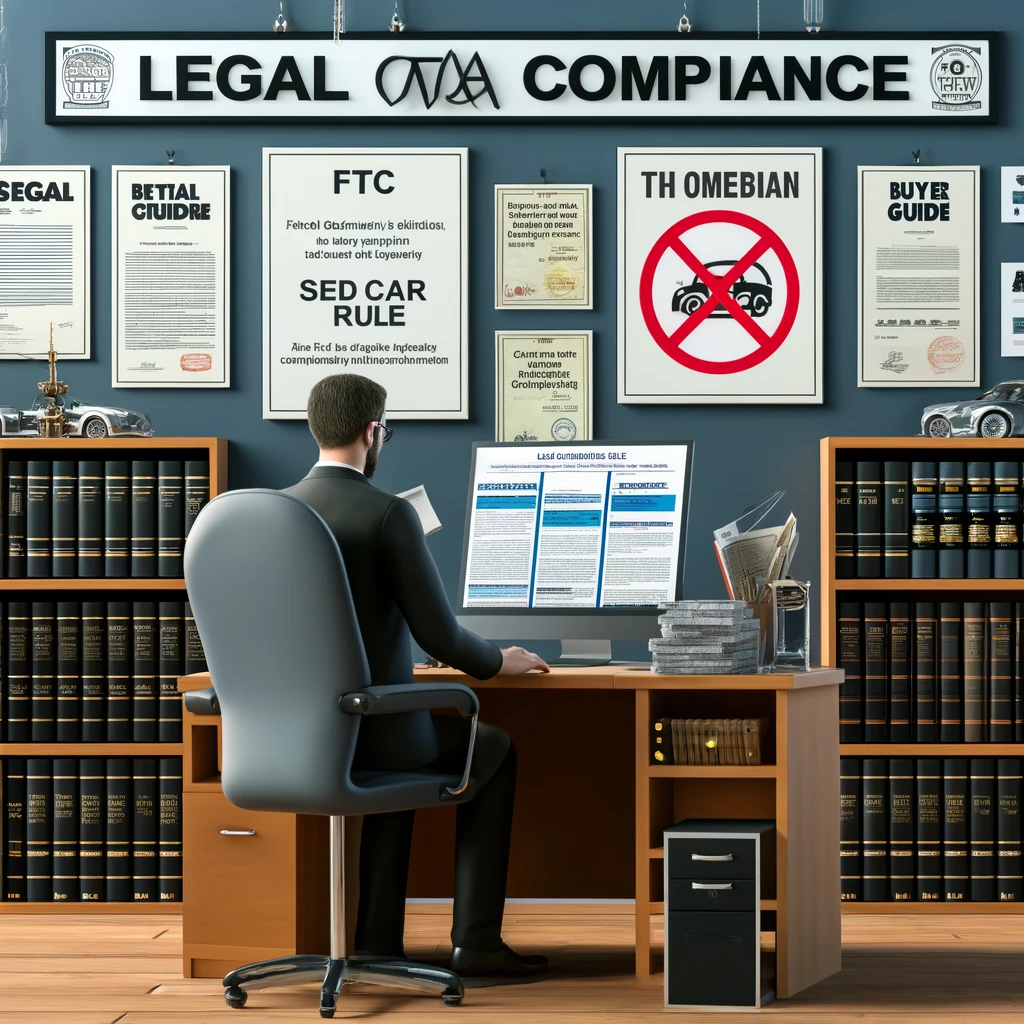
Understanding the FTC's Used Car Rule
The Used Car Rule, enforced by the Federal Trade Commission (FTC), mandates specific disclosures and practices to protect consumers and ensure fair dealings in the used car market. Dealers must be aware of both federal requirements and how these intersect with state regulations.
Penalties for Non-Compliance
Non-compliance with the Used Car Rule can result in severe penalties:
- Financial Penalties: Dealers can face fines up to $51,744 per violation in FTC enforcement actions. Such penalties underscore the importance of adherence to both state and federal laws.
- State and Local Enforcement: In addition to federal enforcement, many states have laws that mirror or incorporate the Used Car Rule. State and local law enforcement may have the authority to impose fines or take legal action against dealers who fail to post Buyers' Guides or other mandated disclosures.
Resources for Compliance
Dealers seeking to comply with the Used Car Rule can access a variety of resources:
- FTC Documentation: Contact the FTC to request a free copy of the Used Car Rule or the staff compliance guidelines, which provide detailed explanations of the Rule's requirements.
- Consumer Protection Efforts: The FTC also works to prevent deceptive and unfair business practices in the marketplace. Dealers can access information designed to help consumers recognize and avoid such practices at the FTC website or by calling their toll-free number.
- Consumer Sentinel Network: The Consumer Sentinel Network is an internet database utilized by law enforcement agencies in the United States. The FTC enters consumer complaints into it. It serves as a vital resource for monitoring and investigating consumer-related issues.
Importance of Compliance
Adhering to the FTC's Used Car Rule is not just about avoiding penalties—it's about maintaining a trustworthy relationship with consumers and ensuring a fair market practice. Compliance helps protect the dealership from legal risks and supports the overall health of the automotive industry by fostering trust and reliability.
7. Self Assessment
Through a detailed self-assessment, evaluate your dealership's compliance with the FTC's Used Car Rule and other regulatory requirements.

Compliance Checklist
To maintain high standards and ensure legal compliance, regularly review your dealership practices against the following questions:
Buyers' Guide Compliance
- Acknowledgment of Receipt: If you include a signature line for the buyer's signature, do you ensure it contains the required disclosure language, "I hereby acknowledge receipt of the Buyers' Guide at the closing of this sale"?
- Clarity and Prominence: Is the Buyer's Guide displayed clearly and prominently on every used vehicle that you have for sale?
- Documentation Accuracy: Are you completing a Buyers' Guide properly for each used vehicle offered for sale?
Contractual Integrity
- Contractual Overriding: Is the information displayed on the window sticker considered part of the agreement, and does it take precedence over any conflicting terms in the sales contract?
- Warranty Disclosure: If you offer a written warranty, is the document prepared in compliance with federal law and readily available for potential buyers to examine?
Post-Sale Documentation
- Guide Distribution: Do you ensure that each buyer receives the Buyers' Guide or a copy at the time of sale, accurately reflecting the final negotiated warranty coverage?
Language Accommodation
- Language-Specific Guides: If a sale is conducted in Spanish, do you provide a Spanish language Buyer’s Guide?
Reflective Questions for Continuous Improvement
- Buyer Education: Do you educate buyers about their rights and the vehicle's warranty coverage?
- Staff Training: Does your staff understand how to effectively fill out and explain the Buyer's Guide to customers?
- Regulatory Updates: Are you keeping up with changes in consumer protection laws and FTC guidelines?
Resource Accessibility
Ensure that you and your staff know where to obtain more information and support:
- FTC Resources: FTC offers resources to provide a free copy of the Used Car Rule and staff compliance guidelines. These resources provide a more detailed explanation of certain aspects of the Rule.
- Consumer Protection Info: For further guidance on preventing fraudulent, deceptive, and unfair business practices, access the FTC's resources at ftc.gov or via its toll-free number.
Conclusion
By conducting regular self-assessments and staying informed about regulatory requirements, you can ensure that your dealership maintains compliance with the FTC's Used Car Rule and other consumer protection laws. This commitment to transparency and legal compliance will help build customer trust and protect your business from potential legal risks.
For a dealer software that streamlines compliance and enhances customer service, consider DealerClick Dealer Management System. Our advanced solutions offer comprehensive tools for managing inventory, customer relations, and compliance requirements, ensuring that your dealership operates efficiently and effectively.

